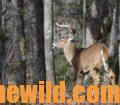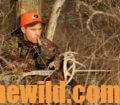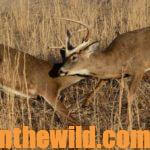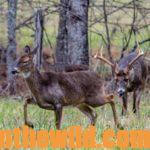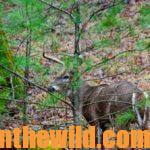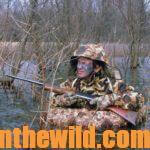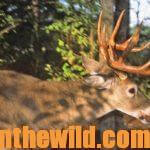Editor’s Note: If hunters will be really honest, sitting 4-5 days in a deer stand when the deer aren’t moving is about as much fun as watching paint dry or maple sap coming down a tree and dripping in a bucket to make maple syrup. But these days can happen. I’m including this week the latest information on hunting deer to help you be more successful: why hunt small properties; why hunt your deer from the skinning shed; how to talk to a buck; and what deer tracks can tell you, besides some of my family’s favorite venison recipes. Luckily several places I deer hunt have potholes where the water collects during the fall or sloughs coming off the main rivers and running through oak bottoms with plenty of acorns floating on top of the water. So, when I tire of hunting deer, and after I’ve watched ducks fly into places like this for 3-4 days and not seen any deer, I’ll let the deer rest. I’ll my shotgun and my waders out of the trunk of my car and wear out those ducks.
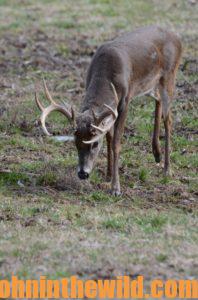 Leading white-tailed deer researcher, Dr. Grant Woods, of Reeds Spring, Missouri, uses the latest scientific technology to track deer movements and learn why deer do what they do. One of Dr. Woods’ most-effective deer tactics is to scout from the skinning shed to identify food sources. He studies the movement patterns of deer, particularly early in bowhunting season, since often the bucks will be moving undisturbed then. Look for deer where deer eat, drink and bed before the rut.
Leading white-tailed deer researcher, Dr. Grant Woods, of Reeds Spring, Missouri, uses the latest scientific technology to track deer movements and learn why deer do what they do. One of Dr. Woods’ most-effective deer tactics is to scout from the skinning shed to identify food sources. He studies the movement patterns of deer, particularly early in bowhunting season, since often the bucks will be moving undisturbed then. Look for deer where deer eat, drink and bed before the rut.
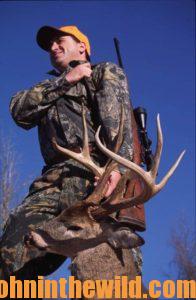 “From the studies I’ve done, the most effective way to discover a nice buck is to scout from the skinning shed, a technique I’ve learned when my company, Woods and Associates, removes nuisance deer from golf courses, airports and other places,” Dr. Woods explains. “We have to take the maximum number of deer possible in the shortest time. As a member of a hunting lease, or when hunting on public lands where deer are checked in and sometimes field dressed, you quickly and easily can learn where and how to see the most deer by being at the skinning shed. Carefully looking at the deer’s stomach contents can tell you exactly what that deer’s been eating. Remember, deer are slaves to their guts.”
“From the studies I’ve done, the most effective way to discover a nice buck is to scout from the skinning shed, a technique I’ve learned when my company, Woods and Associates, removes nuisance deer from golf courses, airports and other places,” Dr. Woods explains. “We have to take the maximum number of deer possible in the shortest time. As a member of a hunting lease, or when hunting on public lands where deer are checked in and sometimes field dressed, you quickly and easily can learn where and how to see the most deer by being at the skinning shed. Carefully looking at the deer’s stomach contents can tell you exactly what that deer’s been eating. Remember, deer are slaves to their guts.”
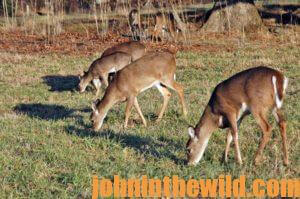 Next you need to determine when deer are eating. Woods splits the buck’s esophagus to learn what he’s eaten just before being harvested. Further back in the stomach is where you’ll find other food content. If the deer has grass in his mouth or in his esophagus, he’s been feeding at the closest time to his harvest on a grass or an alfalfa field. If honeysuckle is discovered lower in the stomach, and then acorns are further back in the stomach, the deer’s eaten that before he’s reached the fields. This knowledge enables the hunter to arrange his morning and afternoon stands in the areas providing these foods.
Next you need to determine when deer are eating. Woods splits the buck’s esophagus to learn what he’s eaten just before being harvested. Further back in the stomach is where you’ll find other food content. If the deer has grass in his mouth or in his esophagus, he’s been feeding at the closest time to his harvest on a grass or an alfalfa field. If honeysuckle is discovered lower in the stomach, and then acorns are further back in the stomach, the deer’s eaten that before he’s reached the fields. This knowledge enables the hunter to arrange his morning and afternoon stands in the areas providing these foods.
Dr. Woods has learned by scouting from the skinning shed that one of the deer’s preferred foods is mushrooms. “I believe and so does retired deer researcher Dr. Larry Marchinton from the University of Georgia that deer become addicted to hallucinogenic mushrooms. Marchinton and I have found that deer will disregard danger to reach those mushrooms when they come up after a rain. The more diverse the habitat you’re hunting, the more critical having different stands for mornings and evenings becomes. Rarely will you find a deer eating in the same places in the mornings that he eats at in the evenings. But if you pinpoint a two-way bottleneck with tracks going in both directions, definitely hang a stand, and hunt there all day.”
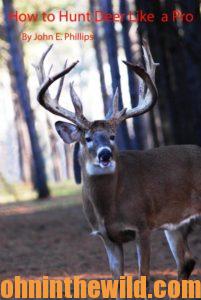
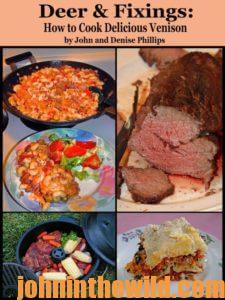 To learn more about hunting deer, check out John E. Phillips’ book, “How to Hunt Deer Like a Pro,” available in Kindle, Print and Audible versions, at (http://amzn.to/YpoQHA). You may have to copy and paste this link into your browser. (When you click on this book, notice on the left where Amazon says you can read 10% of the book for free, and also hear 10% of the Audible version for free). Also check out “Deer & Fixings” cookbook, available at http://amzn.to/WGaJLT.
To learn more about hunting deer, check out John E. Phillips’ book, “How to Hunt Deer Like a Pro,” available in Kindle, Print and Audible versions, at (http://amzn.to/YpoQHA). You may have to copy and paste this link into your browser. (When you click on this book, notice on the left where Amazon says you can read 10% of the book for free, and also hear 10% of the Audible version for free). Also check out “Deer & Fixings” cookbook, available at http://amzn.to/WGaJLT.
Tomorrow: What to Say to a Buck and When and How to Say It

